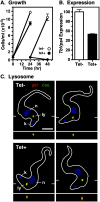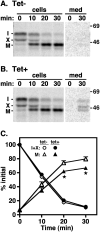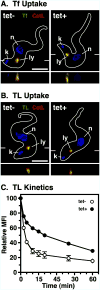Characterization of the late endosomal ESCRT machinery in Trypanosoma brucei
- PMID: 23905922
- PMCID: PMC3806108
- DOI: 10.1111/tra.12094
Characterization of the late endosomal ESCRT machinery in Trypanosoma brucei
Abstract
The multivesicular body (MVB) is a specialized Rab7+ late endosome (LE) containing multiple intralumenal vesicles that function in targeting ubiquitinylated cell surface proteins to the lysosome for degradation. African trypanosomes lack a morphologically well-defined MVB, but contain orthologs of the ESCRT (Endosomal Sorting Complex Required for Transport) machinery that mediates MVB formation. We investigate the role of TbVps23, an early ESCRT component, and TbVps4, the terminal ESCRT ATPase, in lysosomal trafficking in bloodstream form trypanosomes. Both localize to the TbRab7+ LE and RNAi silencing of each rapidly blocks growth. TbVps4 silencing results in approximately threefold accumulation of TbVps23 at the LE, consistent with blocking terminal ESCRT disassembly. Trafficking of endocytic and biosynthetic cargo, but not default lysosomal reporters, is also negatively affected. Others reported that TbVps23 mediates ubiquitin-dependent lysosomal degradation of invariant surface glycoproteins (ISG65) (Leung et al., Traffic 2008;9:1698-1716). In contrast, we find that TbVps23 ablation does not affect ISG65 turnover, while TbVps4 silencing markedly enhances lysosomal degradation. We propose several models to accommodate these results, including that the ESCRT machinery actually retrieves ISG65 from the LE to earlier endocytic compartments, and in its absence ISG65 traffics more efficiently to the lysosome. Overall, these results confirm that the ESCRT machinery is essential in Trypanosoma brucei and plays important and novel role(s) in LE function in trypanosomes.
Keywords: ESCRT; MVB; invariant surface glycoprotein; late endosome; lysosome; trypanosome.
© 2013 John Wiley & Sons A/S. Published by John Wiley & Sons Ltd.
Conflict of interest statement
The authors have no conflicting interests to report.
Figures










Similar articles
-
Late ESCRT machinery mediates the recycling and Rescue of Invariant Surface Glycoprotein 65 in Trypanosoma brucei.Cell Microbiol. 2020 Nov;22(11):e13244. doi: 10.1111/cmi.13244. Epub 2020 Aug 13. Cell Microbiol. 2020. PMID: 32618070 Free PMC article.
-
The role of the PI(3,5)P2 kinase TbFab1 in endo/lysosomal trafficking in Trypanosoma brucei.Mol Biochem Parasitol. 2017 Jun;214:52-61. doi: 10.1016/j.molbiopara.2017.03.005. Epub 2017 Mar 27. Mol Biochem Parasitol. 2017. PMID: 28356223 Free PMC article.
-
Evolution of the multivesicular body ESCRT machinery; retention across the eukaryotic lineage.Traffic. 2008 Sep;9(10):1698-716. doi: 10.1111/j.1600-0854.2008.00797.x. Epub 2008 Jul 14. Traffic. 2008. PMID: 18637903
-
ESCRT-dependent cargo sorting at multivesicular endosomes.Semin Cell Dev Biol. 2018 Feb;74:4-10. doi: 10.1016/j.semcdb.2017.08.020. Epub 2017 Aug 8. Semin Cell Dev Biol. 2018. PMID: 28797838 Free PMC article. Review.
-
ESCRT and Membrane Protein Ubiquitination.Prog Mol Subcell Biol. 2018;57:107-135. doi: 10.1007/978-3-319-96704-2_4. Prog Mol Subcell Biol. 2018. PMID: 30097773 Review.
Cited by
-
Life and times: synthesis, trafficking, and evolution of VSG.Trends Parasitol. 2014 May;30(5):251-8. doi: 10.1016/j.pt.2014.03.004. Epub 2014 Apr 12. Trends Parasitol. 2014. PMID: 24731931 Free PMC article. Review.
-
Guidelines for the purification and characterization of extracellular vesicles of parasites.J Extracell Biol. 2023 Oct 19;2(10):e117. doi: 10.1002/jex2.117. eCollection 2023 Oct. J Extracell Biol. 2023. PMID: 38939734 Free PMC article.
-
Endoplasmic reticulum-associated degradation and disposal of misfolded GPI-anchored proteins in Trypanosoma brucei.Mol Biol Cell. 2018 Oct 1;29(20):2397-2409. doi: 10.1091/mbc.E18-06-0380. Epub 2018 Aug 9. Mol Biol Cell. 2018. PMID: 30091673 Free PMC article.
-
To the Surface and Back: Exo- and Endocytic Pathways in Trypanosoma brucei.Front Cell Dev Biol. 2021 Aug 6;9:720521. doi: 10.3389/fcell.2021.720521. eCollection 2021. Front Cell Dev Biol. 2021. PMID: 34422837 Free PMC article. Review.
-
Exploiting the Achilles' heel of membrane trafficking in trypanosomes.Curr Opin Microbiol. 2016 Dec;34:97-103. doi: 10.1016/j.mib.2016.08.005. Epub 2016 Sep 9. Curr Opin Microbiol. 2016. PMID: 27614711 Free PMC article. Review.
References
-
- Rudenko G. African trypanosomes: the genome and adaptations for immune evasion. Essays Biochem. 2011;51:47–62. - PubMed
-
- Schwede A, Carrington M. Bloodstream form trypanosome plasma membrane proteins: antigenic variation and invariant antigens. Parasitol. 2010;137:2029–2039. - PubMed
-
- Langreth SG, Balber AE. Protein uptake and digestion in bloodstream and culture forms of Trypanosoma brucei. J Protozool. 1975;22:40–53. - PubMed
-
- Morgan GW, Allen CL, Jeffries TR, Hollinshead M, Field MC. Developmental and morphological regulation of clathrin-mediated endocytosis in Trypanosoma brucei. J Cell Sci. 2001;114:2605–2015. - PubMed
-
- Pamer EG, So M, Davis CE. Identification of a developmentally regulated cysteine protease of Trypanosoma brucei. Mol Biochem Parasitol. 1989;33:27–32. - PubMed
Publication types
MeSH terms
Substances
Grants and funding
LinkOut - more resources
Full Text Sources
Other Literature Sources

